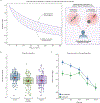Deliberating trade-offs with the future
- PMID: 32184495
- PMCID: PMC7147875
- DOI: 10.1038/s41562-020-0834-9
Deliberating trade-offs with the future
Abstract
Many fundamental choices in life are intertemporal: they involve trade-offs between sooner and later outcomes. In recent years there has been a surge of interest into how people make intertemporal decisions, given that such decisions are ubiquitous in everyday life and central in domains from substance use to climate change action. While it is clear that people make decisions according to rules, intuitions and habits, they also commonly deliberate over their options, thinking through potential outcomes and reflecting on their own preferences. In this Perspective, we bring to bear recent research into the higher-order capacities that underpin deliberation-particularly those that enable people to think about the future (prospection) and their own thinking (metacognition)-to shed light on intertemporal decision-making. We show how a greater appreciation for these mechanisms of deliberation promises to advance our understanding of intertemporal decision-making and unify a wide range of otherwise disparate choice phenomena.
Conflict of interest statement
Competing Interests
The authors declare no competing interests.
Figures


Similar articles
-
Using future thinking to reduce temporal discounting: Under what circumstances are the medial temporal lobes critical?Neuropsychologia. 2016 Aug;89:437-444. doi: 10.1016/j.neuropsychologia.2016.07.002. Epub 2016 Jul 3. Neuropsychologia. 2016. PMID: 27384755 Free PMC article.
-
The role of ventromedial prefrontal cortex in reward valuation and future thinking during intertemporal choice.Elife. 2021 Aug 3;10:e67387. doi: 10.7554/eLife.67387. Elife. 2021. PMID: 34342577 Free PMC article.
-
Effects of episodic future thinking on discounting: Personalized age-progressed pictures improve risky long-term health decisions.J Appl Behav Anal. 2016 Mar;49(1):148-69. doi: 10.1002/jaba.277. Epub 2015 Dec 17. J Appl Behav Anal. 2016. PMID: 26679531
-
A framework for understanding and advancing intertemporal choice research using rodent models.Neurobiol Learn Mem. 2017 Mar;139:89-97. doi: 10.1016/j.nlm.2017.01.004. Epub 2017 Jan 5. Neurobiol Learn Mem. 2017. PMID: 28065715 Free PMC article. Review.
-
The Malleability of Intertemporal Choice.Trends Cogn Sci. 2016 Jan;20(1):64-74. doi: 10.1016/j.tics.2015.09.005. Epub 2015 Oct 5. Trends Cogn Sci. 2016. PMID: 26483153 Free PMC article. Review.
Cited by
-
Perceived Social Support and Health-Related Quality of Life Among Hypertensive Patients: A Latent Profile Analysis and the Role of Delay Discounting and Living Alone.Risk Manag Healthc Policy. 2024 Sep 4;17:2125-2139. doi: 10.2147/RMHP.S476633. eCollection 2024. Risk Manag Healthc Policy. 2024. PMID: 39246592 Free PMC article.
-
Thinking about possibilities: mechanisms, ontogeny, functions and phylogeny.Philos Trans R Soc Lond B Biol Sci. 2022 Dec 19;377(1866):20210333. doi: 10.1098/rstb.2021.0333. Epub 2022 Oct 31. Philos Trans R Soc Lond B Biol Sci. 2022. PMID: 36314156 Free PMC article.
-
A long time ago in a galaxy far, far away: How temporal are episodic contents?Conscious Cogn. 2021 Nov;96:103224. doi: 10.1016/j.concog.2021.103224. Epub 2021 Oct 26. Conscious Cogn. 2021. PMID: 34715457 Free PMC article.
-
Imagining emotional events benefits future-oriented decisions.Q J Exp Psychol (Hove). 2022 Dec;75(12):2332-2348. doi: 10.1177/17470218221086637. Epub 2022 Apr 12. Q J Exp Psychol (Hove). 2022. PMID: 35225089 Free PMC article. Clinical Trial.
-
Exploring behavior patterns in human and machine interactions.Fundam Res. 2024 Feb 8;5(3):1246-1257. doi: 10.1016/j.fmre.2023.12.021. eCollection 2025 May. Fundam Res. 2024. PMID: 40528957 Free PMC article.
References
-
- Plato. Protagoras. in B. Jowett and M. Ostwald Translation (ed. Vlastos G) (Bobbs-Merrill, 1956).
-
- Smith A Adam Smith: The theory of moral sentiments. Cambridge Texts in the History of Philosophy (Cambridge University Press, 1759). doi:DOI: 10.1017/CBO9780511800153 - DOI
-
- Strotz RH Myopia and inconsistency in dynamic utility maximization. Rev. Econ. Stud 23, 165–180 (1955).
-
- Ericson KM & Laibson D Intertemporal choice in Handbook of Behavioral Economics - Foundations and Applications 2, Volume 2 (eds. Bernheim BD, DellaVigna S & Laibson D) 1–67 (North-Holland, 2019). doi:10.1007/978-3-642-36172-2_7034 - DOI
Publication types
MeSH terms
Grants and funding
LinkOut - more resources
Full Text Sources

